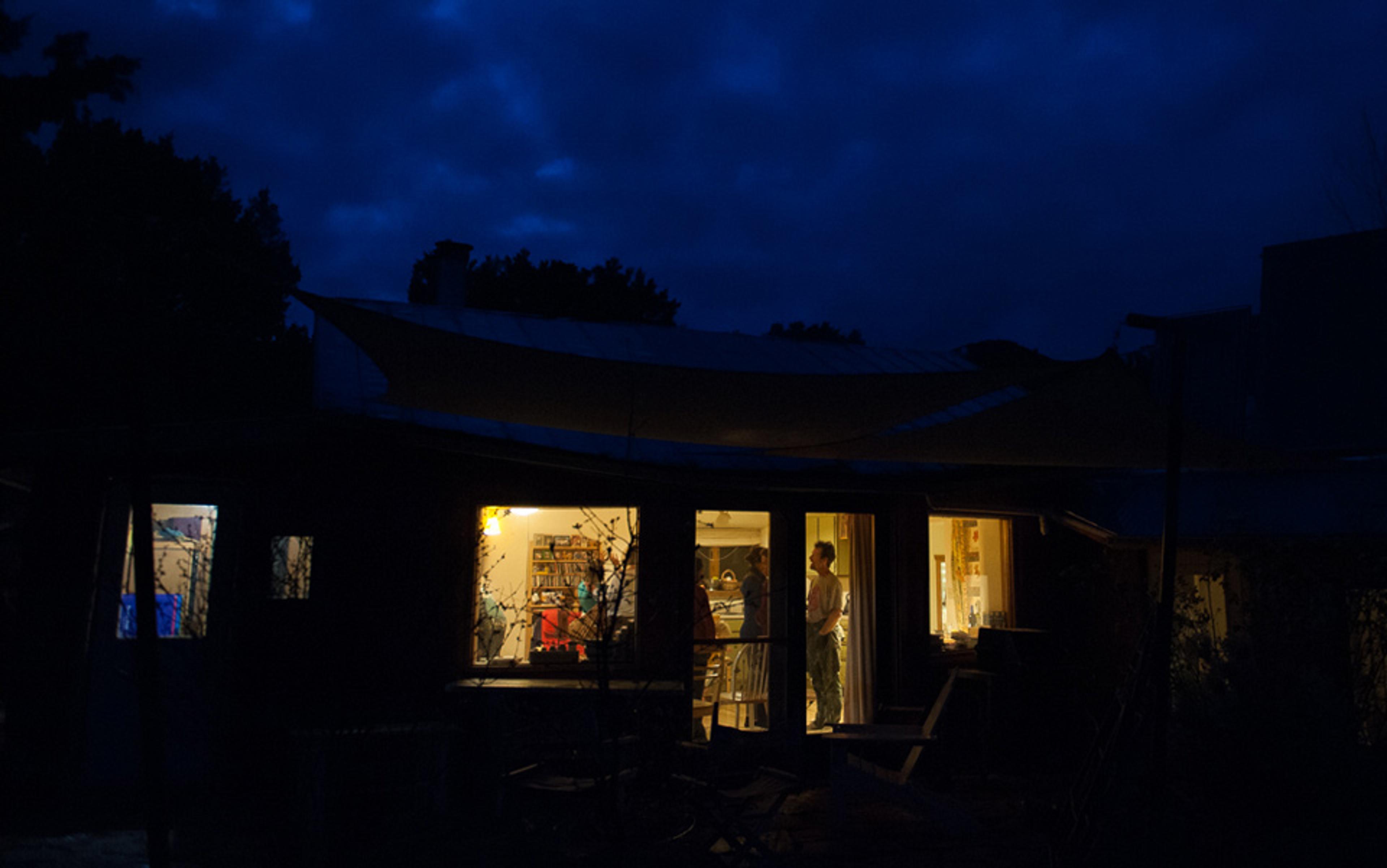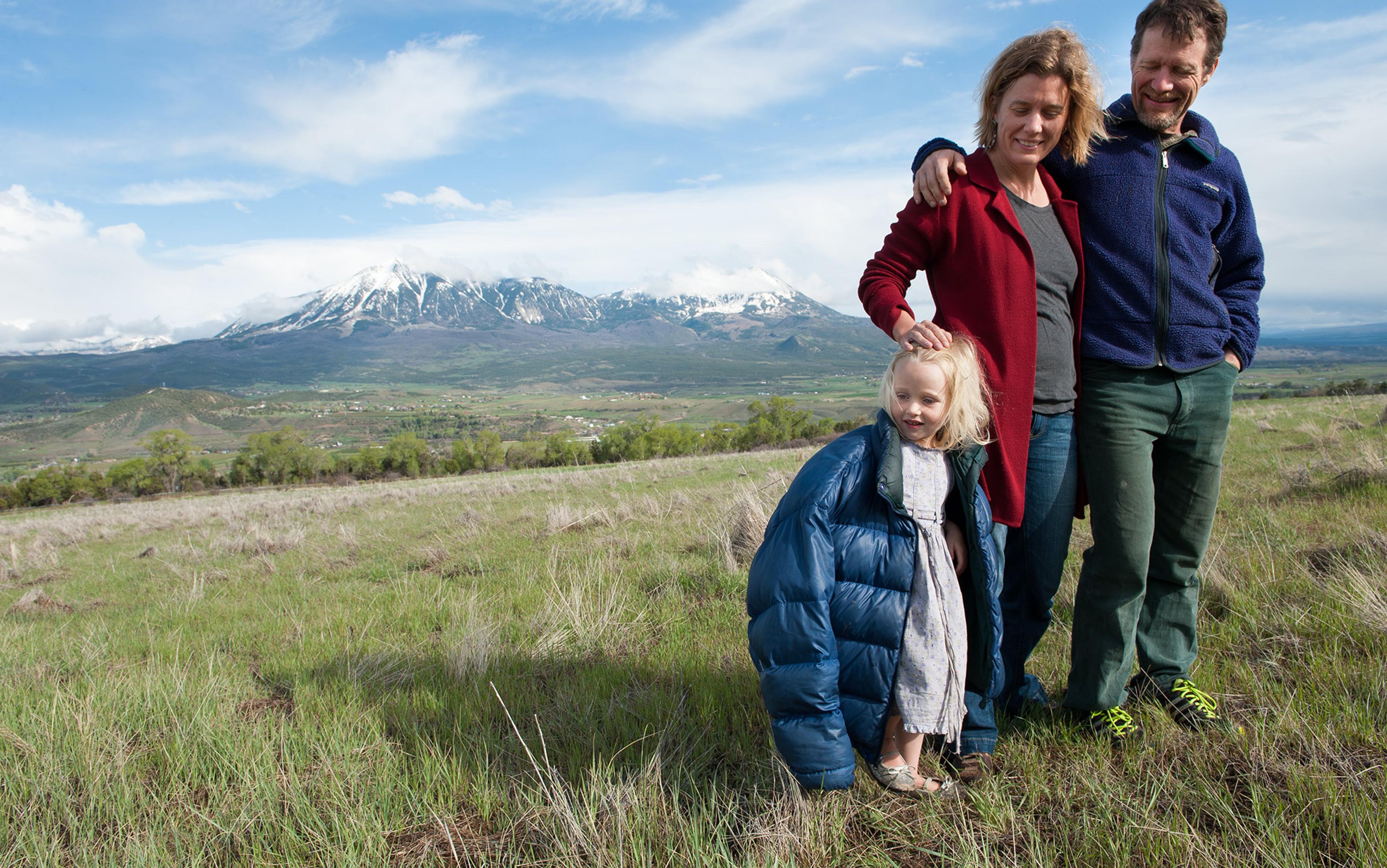Once upon a time — 20 years ago, that is — seven friends bought a cheap piece of land in western Colorado, 80 acres between the redrock deserts of the Colorado Plateau and the foothills of the Rocky Mountains. Like most people who do such things, they were young, idealistic, and generally overjoyed by their ability to survive on almost nothing at all.
The land was cheap for good reasons: it was high on a mesa, thick with rocks, and spiked with scraggly juniper trees. Worse, it was uphill from the irrigation ditch, the broad artery that drew water from the river and directed it toward orchards and farms. To locals, all land was defined by its position above or below the ditch, and land above was useless, too dry for growing anything but a few cows. People who invested in it were desperate, or fools. Or both.
But the friends saw something different in the land. They saw acreage they could afford, at a time in their lives when everyone they knew was struggling just to make rent. They saw sheltered spots where they could try building their own houses. They saw a place where they could unplug from the electrical grid — and from a society they saw as wasteful and destructive.
So they haggled, pooled their savings, paid up and moved in. That first summer, they lived outdoors, in tents and on plywood mattress platforms, cooking in aluminium pots on a single camp stove. They built their first house out of discarded wooden beams and scraps of corrugated steel, finishing just before the first snowfall.
For the first time in their lives, the friends were living as they thought they should, consuming as little and reusing as much as they could. They went without electricity or telephones, hauled water and groceries up the hill by hand, and rode their bikes even through the snow and ice. The houses multiplied bit by disorderly bit, built with mud and old wood and hazily remembered Boy Scout skills, insulated with straw and the odd discarded refrigerator. Over time, the place became more civilised, installing solar panels, rainwater collection systems and a few propane tanks for hot showers, but daily life still required muscle and a tolerance for mild deprivation.
They invested their time in the ways they thought mattered, teaching and writing and tending to the sick. They fell in and out of love. There were marriages and, eventually, a baby. There were late-night campfires, and wide‐angle views of sky and stars and thunderstorms.
Those first years should have been hard, and at times they were. But mostly, they were full of jokes and adventures and something close to contentment.
At least, that’s what I’ve been told. I wasn’t there. When I married into the land, a few years after the commune began, I was as enthralled as the original seven pioneers. I, too, was an idealist and a wannabe do-it-yourselfer: I’d read my Thoreau, and swallowed it whole. I was a thrifty Yankee with a big crush on the American West.
I loved the tiny straw-bale house my husband had built on the downhill edge of the property, not only for its simple beauty but also for its efficiency: cool in summer and warm in winter, it seemed to sip energy as delicately as a hummingbird. I loved my neighbours, whose chaotic resumes ranged from carpentry to Japanese translation. I didn’t mind the composting toilets. There seemed no more perfect place to be.
None of us had taken a vow of carbon purity. We all used fossil fuels when love or money required them, travelling for work and to see family at holidays. We knew it was impossible to be truly ‘off the grid’, no matter how many solar panels we had — after all, the grid still provided much of our food and clothing and gasoline. But as global climate forecasts worsened, there was something deeply calming about knowing that our power at home came straight from the sun, and our water from the sky. We knew we didn’t have the solution — we didn’t even have a solution, not yet — but our eccentric experiment in low-carbon, low‐cost living was underway, and so far we liked the results.
The quiet was thick and heavy, except when the coyotes, with their healthy sense of theatre, howled into the moonlight
Though we weren’t separate from the world, it was easy to forget the connections. A rutted gravel road, our only line to civilisation, snaked around the steep northern edge of the property. We were a mile and a half from town, 30 miles from a Walmart, 70 miles from a Starbucks, and more than an hour’s drive from anything that qualified as an airport. The quiet was thick and heavy, except when the coyotes, with their healthy sense of theatre, howled into the moonlight.
For a long time, the isolation was romantic. And we knew it was part of what had made the land affordable in the first place, allowing us to insulate ourselves from mortgages and power outages. But as we discovered, it made us vulnerable, too. When Nancy, a chiropractor, was diagnosed with breast cancer, she moved east to be closer to her extended family and to medical care. When Marc, an architect, was struck by a neurological disorder that left him unable to walk and speak, he and his family left for a larger town with wheelchair ramps and social services.
Another couple moved away to pursue careers in journalism and political activism, professions the mesa couldn’t easily support. One by one, for one reason and another, the original landowners ran up against the limits of the place, and regretfully they left for different lives.
Finally, on a spring day a decade and a half after the seven friends bought the land, my husband, our infant daughter and I found ourselves the only permanent residents of the entire 80 acres, living in what suddenly felt like a gatehouse to nowhere.
The land wasn’t easy to love. The locals had warned as much, and for years I hadn’t believed them. But when the place emptied, I started to see it as others did. During the hot, dry, summer that followed, our wide‐open spaces choked with pale weeds, and the juniper trees seemed to crowd in on us. Every rumble of thunder was a reminder that a wildfire could sweep the place bare, taking our uninsured little houses with it. Our bedraggled, neglected gardens suffered from drought, deer, and hordes of grasshoppers.
The cool relief of fall spiralled quickly into winter, which seemed darker, colder, and longer than ever. I stumbled blearily through new‐parent sleep deprivation, telling myself that everything would look better in the spring. In the early days, the extremes of the seasons had seemed just part of the pioneer challenge, annoyances to laugh at and shrug off. But during those dull winter evenings, my sense of humour shrivelled from disuse. When spring arrived, I went to a wedding, a reunion of sorts for the original landowners, and listened to old friends laugh over stories around the fire. Grumpily, I thought, It’s not like that anymore.
We were lucky, though, my husband and I. We were healthy, with a roof over our heads and satisfying work, and while the neighbourhood was quieter than we liked, the isolation was no mortal threat. And after a year or so, it began to ease. The son of one of the original landowners moved back to the land, bringing his partner and their two little girls. Two of the landowners returned from teaching jobs in a nearby city. Families and couples came to housesit and rent, exclaiming over the mountain views and keeping us company around the campfires.

At night in the house on the mesa. Photo by JT Thomas
Our daughter learned to walk, then run, on the rocky ground, and soon she was climbing our garden walls. The stray vine outside the front door bore a huge orange pumpkin that somehow survived the grasshoppers, deer and ravens.
My husband and I looked around. The place was still beautiful — not as rose‐coloured as it once had been, but beautiful in a stark, familiar way. We chose it again, ghosts and weeds and all, and then again.
But we, too, were testing the limits of the place and ourselves, testing our tolerance for isolation and aridity. Finally, like pavement weakened by too many cycles of heat and frost, our resistance buckled and cracked.
Now I see the mesa as a kind of training ground, a place that prepared us to begin another experiment
My husband, a teacher, had begun to crave more stimulating work than he could find in our nearby small town. And every summer, he admitted, he longed more and more for the green forests and waterfalls of his native Oregon. Our daughter was happy here now, with us and our dog and the occasional visit from a friend, but what would her teenage years be like? What had for so long been heaven for us could feel like prison to her.
So we sighed, and thought, and talked. My husband applied for a job in the Pacific Northwest, and we visited our prospective new town, which was gray and wind‐whipped and backed by snow‐covered volcanoes. It wasn’t home. But in many ways, we realised, neither was the land. At some unnoticed moment during those lonely evenings and sun-bleached afternoons, we had fallen out of love with it. We had stayed on not out of affection, but out of stubbornness. We chose to go.
We left as our friends had before us, quietly and regretfully, with promises to return often. We probably will, but — like the others — not as often as we intend. Unplugging from the electrical grid was easy, or relatively so. What we didn’t realise was that we needed the human grid, too. We could replicate it for a while, in our beautifully isolated little neighbourhood, but in the end the longing for deeper, sturdier, more numerous human connections pulled all of us away from the mesa.
It’s easy to see our experiment as a failure, as yet another innocent, short‐lived attempt to shrink the resources that all of us used. And maybe the land was just a holiday spot, a place where a group of friends bonded over youthful adventures before retreating to normal plumbing and hydropower and better-funded schools.
But I don’t think so. My family’s 15 years there changed the land, and it changed each of us. In our new town, we live just a block from a lively main street, in a house where the toilet flushes, the lights never dim, and the neighbours’ dinner conversation floats over the back fence. But we don’t use any more power than we did off the grid, and we drive less. The habit of frugality has stuck, so much so that it’s no longer a hardship.
Now I see the mesa as a kind of training ground, a place that prepared us to begin another experiment. We’re trying to take what we learned off the grid and sustain it in a new place, one that’s embedded in society instead of isolated from it.
Our Colorado ghost commune persists without us, populated by a rotating cast of strangers and old friends. A few have settled there for good, but most will move on as we did, taking their stories and, with luck, their new habits with them. Yet all of us — the seven original pioneers, my young daughter, the families that come and go after us — leave some piece of ourselves behind. As we scatter over states and continents, we remain connected, a human grid tempered in flickering campfires.






